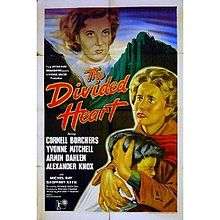The Divided Heart
The Divided Heart is a black-and-white British film directed by Charles Crichton and released in 1954. The film is a drama, based on a true story[1][2] of a child, whose father was a member of Slovenian Partisans executed by Nazis and whose mother was deported to the Auschwitz concentration camp, while little Ivan was, like other 300 babies and young children from Slovenia, whose parents were declared Banditen by Nazis, sent to Germany in a Nazi program known as Lebensborn.
| The Divided Heart | |
|---|---|
 The Divided Heart UK release poster | |
| Directed by | Charles Crichton |
| Produced by | Michael Truman |
| Written by | Jack Whittingham and Richard Hughes |
| Starring | Cornell Borchers Yvonne Mitchell Armin Dahlen Alexander Knox |
| Music by | Georges Auric |
| Cinematography | Otto Heller |
| Edited by | Peter Bezencenet |
| Distributed by | Ealing Studios |
Release date | 9 November 1954 (UK) 11 August 1955 (U.S.) |
Running time | 89 min. |
| Country | United Kingdom |
| Language | English |
The script was written by Jack Whittingham and Richard Hughes. It was produced by Michael Truman and edited by Peter Bezencenet, with cinematography by Otto Heller and music by Georges Auric. The Divided Heart was widely admired, and won three British Academy Film Awards.
Plot
During World War II, a three-year-old boy is found wandering alone in Germany. No family can be traced, and it is presumed that his parents and siblings have been casualties of war. The child is placed in an orphanage, from where he is subsequently adopted by a childless couple, whom he grows to love and accept as his parents. When the boy is 10 years old, his natural mother is found alive in Yugoslavia where she has survived the war as a refugee. She returns to Germany to claim her child, having lost her husband and two other children in the war. The film focuses on the moral dilemma of the situation: should the child remain with the adoptive parents who have given him a loving and happy home, or be returned to his natural mother who has lost everything else, and to what extent should the child's own wishes be taken into account? The case is finally referred to a three-man court, who will decide the child's future. As in the true story on which the film is based, he is returned to his biological mother.
Cast
- Cornell Borchers as Inga
- Yvonne Mitchell as Sonja
- Armin Dahlen as Franz
- Alexander Knox as Chief Justice
- Geoffrey Keen as Marks
- Liam Redmond as First Justice
- Eddie Byrne as Second Justice
- Theodore Bikel as Josip
- Pamela Stirling as Mlle. Poncet
- Michel Ray as Toni (aged 10)
- Martin Stephens as Hans
- André Mikhelson as Professor Miran
- John Schlesinger as the Ticket Collector
- Richard Molinas as Herr Pieter
- Alec McCowen as Reporter
Reception and awards
The Divided Heart was a popular and critical success, being highly praised for its sensitivity, emotional impact and the even-handedness with which it dealt with its subject matter. While noting that the film's ending reportedly left many viewers feeling disappointed and let down, critics conceded that it would have been impossible for a storyline of this nature to reach a conclusion which pleased everyone. In a contemporary review in the New York Times, noted critic Bosley Crowther wrote: "This is a bleak, heart-rending problem, as it is finely presented in this film with exceptionally sensitive understanding and scrupulous integrity. And the fact that it cannot be unraveled to the satisfaction of all...is simply an indication that a happy solution is beyond the power of a man as wise as Solomon—or even the author of the script—to hit upon."[3]
The Divided Heart was nominated in six categories at the 1955 British Academy Film Awards and won three, with Mitchell being named Best British Actress and Borchers picking up the Best Foreign Actress award. Separate awards for British and foreign actresses were given between 1952 and 1967 (after which they were combined into one Best Actress award), and this was the only year in which both awards were won by actresses from the same film. The film also won the UN Award. It also received nominations in the Best Film and Best British Film categories, and Whittingham was nominated for Best British Screenplay.[4] In the U.S., The Divided Heart was named among the top 5 foreign films at the 1955 National Board of Review Awards.[5]
References
- A stolen boy – and a divided heart, Slovenia Revealed, TV Slovenia website, 2015
- Life Magazine 13 October 1952
- "The Divided Heart" review by Bosley Crowther New York Times, 4 August 1955. Retrieved 22 July 2010
- British Academy Film Awards 1955 - winners and nominations Retrieved 22 July 2010
- National Board of Review - awards for 1955 Archived 29 September 2007 at the Wayback Machine Retrieved 22 July 2010